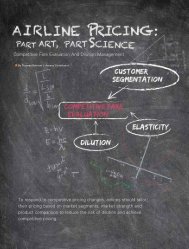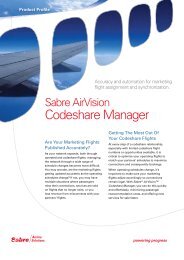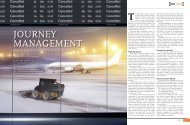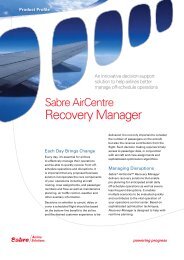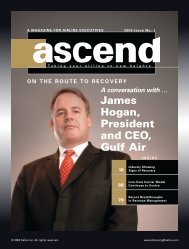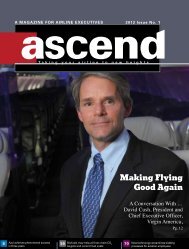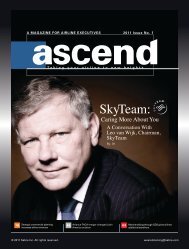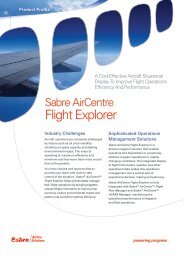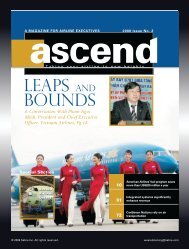2009 Issue 1 - Sabre Airline Solutions
2009 Issue 1 - Sabre Airline Solutions
2009 Issue 1 - Sabre Airline Solutions
You also want an ePaper? Increase the reach of your titles
YUMPU automatically turns print PDFs into web optimized ePapers that Google loves.
to be implemented globally. Within a year, the FAA<br />
followed suit with regard to its Pacific airspace.<br />
Air New Zealand has invested in aircraft<br />
systems that enable the carrier to obtain approval<br />
for both RNP10 (which results in 50-nautical-mile<br />
lateral and longitudinal separation) and RNP4<br />
(which allows the use of a 30-nautical-mile standard<br />
in oceanic regions).<br />
This separation standard is now routinely<br />
applied on flights between Auckland and San<br />
Francisco, and 30/30 separation effectively pro-<br />
vides the Airways New Zealand agency significantly<br />
increased airspace capacity as well as<br />
increased route flexibility, thereby enabling an<br />
overall reduction in fuel burn and CO2 emissions<br />
from each and every aircraft operating in the<br />
region.<br />
Air traffic control’s ability to allow closer<br />
separation between aircraft therefore also reduces<br />
the number of times during which aircraft are held<br />
below the optimum altitude, and on this Air New<br />
Zealand flight resulted in savings of approximately<br />
According to Air New zealand, approximately 61 percent of the total fuel savings<br />
on its AsPIre 1 flight last september were attributed to the carrier’s state-of-the-art<br />
flight planning system, Dispatch Manager, part of <strong>Sabre</strong> ® AirCentre Enterprise Operations.<br />
135 U.S. gallons of fuel and 1,290 kilograms in<br />
reduced CO2 emissions.<br />
The crew of the Air New Zealand flight<br />
was also able to make use of new descent and<br />
arrival procedures into San Francisco International<br />
Airport that saved approximately 200 U.S. gallons<br />
of fuel and 1,912 kilograms in reduced CO2<br />
emissions.<br />
Through what is known as a tailored arrival,<br />
the descent and approach into San Francisco was<br />
optimized for efficiency.<br />
Tailored arrival into San Francisco is a<br />
sophisticated application of a type of emissionsoptimized<br />
arrival known as a continuous descent<br />
arrival. CDA allows an aircraft to fly a continuousdescent<br />
path to land at an airport, instead of the<br />
traditional step-downs or intermediate-level flight<br />
operations.<br />
Using CDA, the pilot initiates descent from<br />
a high altitude in a near-idle (or low-power) engine<br />
condition until reaching a stabilization point prior to<br />
touchdown on the runway. CDA results not only<br />
in fuel savings and decreased emissions, but also<br />
significantly reduces noise beyond the airport.<br />
The tailored arrival then takes the principles<br />
of the CDA a step further by identifying the most<br />
beneficial flight path available by integrating all<br />
known aircraft performance, air traffic, airspace,<br />
meteorological, obstacle-clearance and environmental<br />
constraints expected to be encountered<br />
during the arrival phase.<br />
So in a broad analysis, the combination of<br />
Air New Zealand’s desire to pursue a “green”<br />
approach in the air — combined with state-ofthe-art<br />
technologies as well as innovative air traffic<br />
control systems from government agencies,<br />
Airways New Zealand, Airservices Australia and<br />
the FAA — made this particular Air New Zealand<br />
flight something of a high-profile case study, worthy<br />
of both detailed analysis and emulation.<br />
And the entire aviation industry appears<br />
to have taken notice. In a remarkable globally<br />
significant accomplishment, Air New Zealand has<br />
effectively demonstrated how to operate aircraft<br />
over long oceanic distances while creating a<br />
considerably smaller environmental footprint and<br />
saving substantial amounts of fuel.<br />
Today, there are more than 150 flights per<br />
week connecting New Zealand and Australia to<br />
the United States and Canada. Based on these<br />
flights alone, the potential total annual savings are<br />
in excess of 10 million U.S. gallons of fuel and<br />
reduced CO 2 emissions of more than 100,000<br />
tons … simply by following the principles that<br />
have been established and proven effective by Air<br />
New Zealand during a memorable flight from<br />
Auckland to San Francisco. a<br />
Shawn Mechelke is an operations<br />
product management director for <strong>Sabre</strong><br />
<strong>Airline</strong> <strong>Solutions</strong>®. He can be contacted<br />
at shawn.mechelke@sabre.com.<br />
ascend<br />
15<br />
profile



